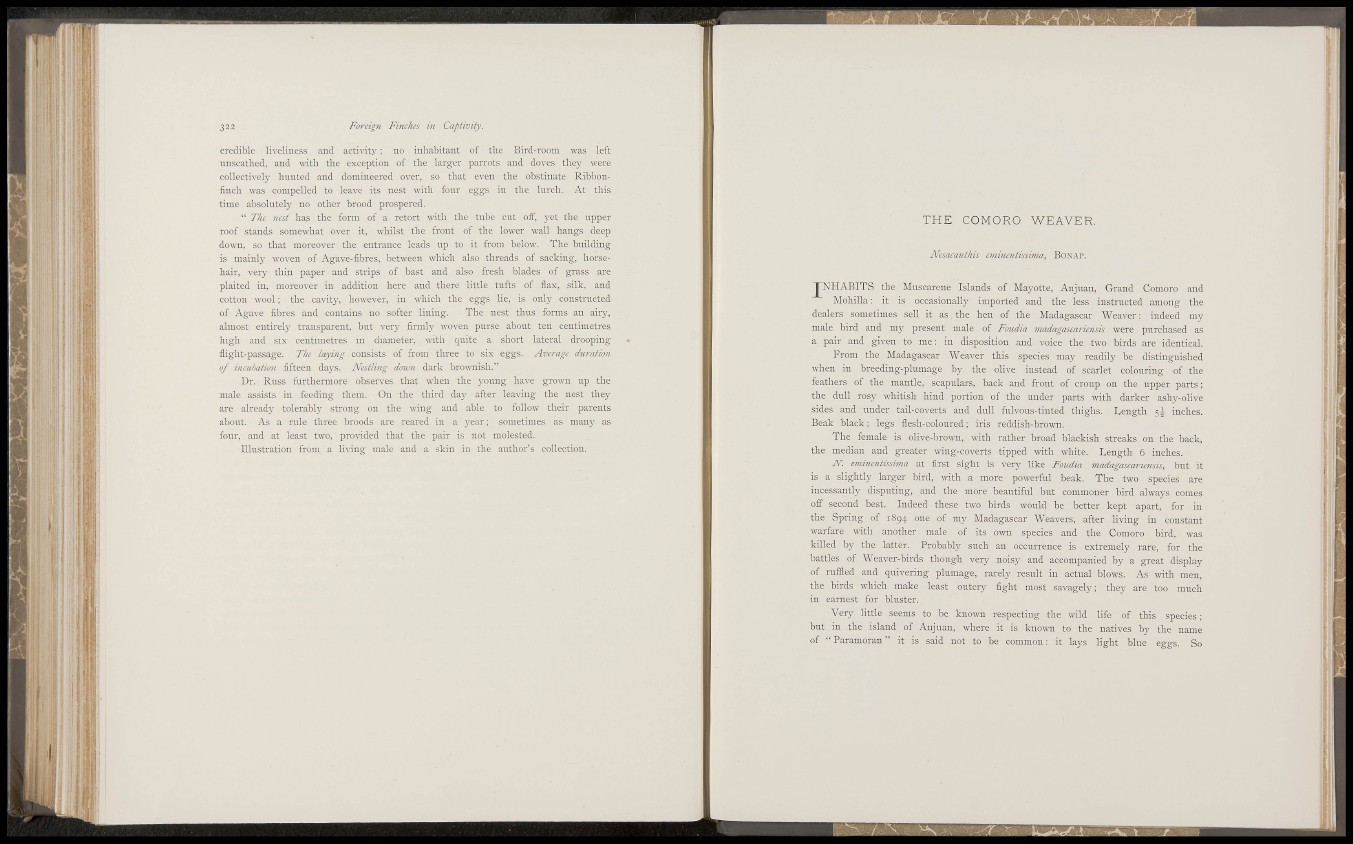
9 i
I,'
t.ir
• i ii:
' M
r I
) '
riii
1 • 'U
322 Fordgn Finches in Captivity.
credible liveliness and activity ; no inhabitant of tlie Bird-room was left
unscathed, and with the exception of the larger parrots and doves they were
collectively hnnted and domineered over, so that even the obstinate Ribbonfinch
was compelled to leave its nest with four eggs in the lurch. At this
time absolutely no other brood prospered.
" The nest has the form of a retort with the tube cut off, yet the upper
roof stands some^vhat over it, whilst the front of the lower wall hangs deep
down, so that moreover the entrance leads up to it from below. The buildingis
mainly woven of Agave-fibres, between which also threads of sacking, horsehair,
very thin paper and strips of bast and also fresh blades of grass are
plaited in, moreover in addition here and there little tufts of flax, silk, and
cotton wool ; the cavity, however, in which the eggs lie, is only constructed
of Agave fibres and contains no softer lining. The nest thus forms an airj.%
almost entirely transparent, but very- firml}- woven purse aboiit ten centimetres
high and six centimetres in diameter, with quite a short lateral drooping
flight-passage. The laying consists of from three to six eggs. Average duration
of inctibation fifteen days. Nestling down dark brownish."
Dr. Russ furthermore observes that when the young have grown up the
male assists in feeding them. On the third daj- after leaving the nest they
are already tolerably strong on the wing and able to follow their parents
about. As a rule three broods are reared in a year; sometimes as man}^ as
four, and at least two, provided that the pair is not molested.
Illustration from a living male and a skin in the author's collection.
THE COMORO WEAVER.
Nesacaiithis eminentissima, BONAP.
J N H A B I T S the Muscarene Islands of Mayotte, Anjnan, Grand Comoro and
Mohilla: it is occasionally imported and the less instructed among the
dealers sometimes sell it as. the hen of the Madagascar Weaver: indeed my
male bird and my present male of Fotidia madagaseariensis were purchased as
a pair and given to me: in disposition and voice the two birds are identical.
From the Madagascar Weaver this species may readily be distinguished
when in breeding-plumage by the olive instead of scarlet colouring of the
feathers of the mantle, scapulars, back and front of croup on the upper parts;
the dull rosy whitish hind portion of the under parts with darker ashy-olive
sides and under tail-coverts and dull fulvous-tinted thighs. Length 5I inches.
Beak black; legs flesh-coloured; iris reddish-brown.
The female is olive-brown, with rather broad blackish streaks on the back,
the median and greater wing-coverts tipped with white. Length 6 inches.
eminentissima at first sight is very like Foiidia madagaseariensis, but it
is a slightly larger bird, with a more powerful beak. The two species are
incessantly disputing, and the more beautiful but commoner bird always comes
off second best. Indeed these two birds would be better kept apart, for in
the Spring of 1894 one of my Madagascar Weavers, after living in constant
warfare with another male of its own species and the Comoro bird, was
killed by the latter. Probably such an occurrence is extremely rare, for the
battles of Weaver-birds though very noisy and accompanied by a great display
of ruffied and quivering plumage, rarely result in actual blows. As \vith men,
the birds which make least outcry fight most savagely; they are too much
in earnest for bluster.
Very little seems to be known respecting the wild life of this species ;
but in the island of Anjnan, where it is known to the natives by the name
of " Paramoran " it is said not to be common: it lays light blue eggs. So
1 r
i i!,
? r
I
L
i
J
(
i f
i!". Ii- -.
r I
f h
. t